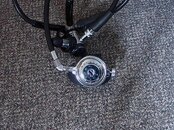scubafanatic
Contributor
- Messages
- 5,090
- Reaction score
- 910
I recently acquired a couple of MK 5/109 reg sets, Originally I really only wanted the 109 2nd stages, the MK5 1-st stages were just part of the deals.
One set is a NIB (minus the actual original box) where the 1st stage has 1 HP / 4 LP ports, and no PSI rating is stamped on the yoke 1st-stage. (as this set is new/old stock, it has NOT been refreshed with an annual service or anything, so it's NOT dive ready until I take it in for inspection/service.) No SPEC cap installed.
The other set is a later version, with 2 HP / 5 LP ports, yoke is stamped @ 3000 PSI. It's not NIB, but it looks new, as was fully serviced by the seller. It appears to have the SPEC cap installed.
(both sets have the 'old' metal banana shaped yoke wing nut)
For the time being, I'm not doing anything with the 'older' version set, as it only has 1 HP port, and a yoke of unknown PSI 'rating'. I AM planning to get the newer version set fully up and running. I'm looking for suggested upgrades to bring either/both these regs up to their full potential, but have never dove/owned SP regs until now. I've strated reading SB about these 1st and 2nd stages, and here's what suggested 'upgrades' I've seen/or thought about, so far:
1) upgrade the 109's to the 'balanced' 156 version
2) make sure the 1st-stage swivel nut is Stainless Steel, instead of the OEM brass version (available at Vintagedoublehose.com @ $ 15 each)
3) upgrade the yoke to something beyond 3000 PSI, assuming such an upgrade part even exists ? (would anyone have a problem diving the 3000 PSI yoke with a HP steel tank filled to 3500 PSI ?) Would the 1st-stage internals even be able/rated to handle a 3500 PSI fill ?
MK5 1st-stage service kits run $ 15 @ VDH
other parts I saw: OEM Scubapro 2nd stage orifice Part # 11500-109 Fits all 109's and G250's $ 6 each
....additionally, I'll admit I'm a little concerned about the extra maintainance of diving an unsealed piston 1st-stage (all my other egs are either diaphragms or sealed piston Atomics).
I'm debating sending the work to either my not-so-local SP dealer or maybe Bryan @ VDH ? Odds are I'd need to try Bryan as many dealers would have 'issues' installing a non-OEM upgrade like the SS 'swivel nut'.
Can anyone think of any other upgrades / pitfalls I might want to consider on this project ?
Thanks, Karl
One set is a NIB (minus the actual original box) where the 1st stage has 1 HP / 4 LP ports, and no PSI rating is stamped on the yoke 1st-stage. (as this set is new/old stock, it has NOT been refreshed with an annual service or anything, so it's NOT dive ready until I take it in for inspection/service.) No SPEC cap installed.
The other set is a later version, with 2 HP / 5 LP ports, yoke is stamped @ 3000 PSI. It's not NIB, but it looks new, as was fully serviced by the seller. It appears to have the SPEC cap installed.
(both sets have the 'old' metal banana shaped yoke wing nut)
For the time being, I'm not doing anything with the 'older' version set, as it only has 1 HP port, and a yoke of unknown PSI 'rating'. I AM planning to get the newer version set fully up and running. I'm looking for suggested upgrades to bring either/both these regs up to their full potential, but have never dove/owned SP regs until now. I've strated reading SB about these 1st and 2nd stages, and here's what suggested 'upgrades' I've seen/or thought about, so far:
1) upgrade the 109's to the 'balanced' 156 version
2) make sure the 1st-stage swivel nut is Stainless Steel, instead of the OEM brass version (available at Vintagedoublehose.com @ $ 15 each)
3) upgrade the yoke to something beyond 3000 PSI, assuming such an upgrade part even exists ? (would anyone have a problem diving the 3000 PSI yoke with a HP steel tank filled to 3500 PSI ?) Would the 1st-stage internals even be able/rated to handle a 3500 PSI fill ?
MK5 1st-stage service kits run $ 15 @ VDH
other parts I saw: OEM Scubapro 2nd stage orifice Part # 11500-109 Fits all 109's and G250's $ 6 each
....additionally, I'll admit I'm a little concerned about the extra maintainance of diving an unsealed piston 1st-stage (all my other egs are either diaphragms or sealed piston Atomics).
I'm debating sending the work to either my not-so-local SP dealer or maybe Bryan @ VDH ? Odds are I'd need to try Bryan as many dealers would have 'issues' installing a non-OEM upgrade like the SS 'swivel nut'.
Can anyone think of any other upgrades / pitfalls I might want to consider on this project ?
Thanks, Karl





